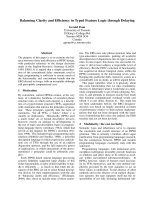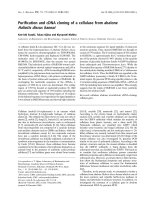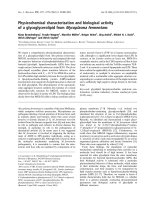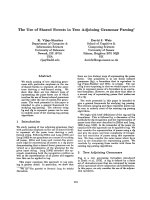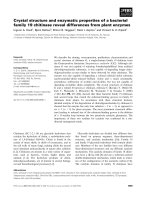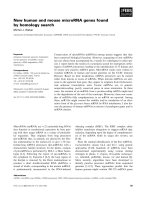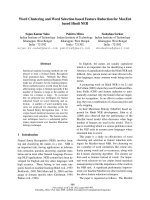Báo cáo khoa học: "INCORPORATING INHERITANCE AND FEATURE STRUCTURES INTO A LOGIC GRAMMAR FORMALISM" pptx
Bạn đang xem bản rút gọn của tài liệu. Xem và tải ngay bản đầy đủ của tài liệu tại đây (401.61 KB, 7 trang )
INCORPORATING INHERITANCE AND FEATURE STRUCTURES
INTO A LOGIC GRAMMAR FORMALISM
Harry H. Porter, III
Oregon Graduate Center
19600 N.W. Von Neumann Dr.
Beaverton Oregon 97008-1999
ABSTRACT
Hassan Ait-Kaci introduced the #/-term,
an informational structure resembling feature-
based functional structures but which also
includes taxonomic inheritance (Ait-Kaci, 1984).
We describe e-terms and how they have been
incorporated into the Logic Grammar formal-
ism. The result, which we call Inheritance
Grammar, is a proper superset of DCG and
includes many features of PATR-II. Its taxo-
nomic
reasoning facilitates semantic type-class
reasoning during grammatical analysis.
INTRODUCTION
The Inheritance Grammar (IG) formalism
is an extension of Hassan Ait-Kaci's work on #/-
terms (Ait-Kaci, 1984; Ait-Kaci and Nasr,
1986). A e-term is an informational structure
similar to both the feature structure of PATR-II
(Shieber, 1985; Shieber, et al, 1986) and the
first-order term of logic, e-terms are ordered by
subsumption and form a lattice in which
unification of #/-terms amounts to greatest lower
bounds (GLB, [-']). In Inheritance Grammar, #/-
terms are incorporated into a computational
paradigm similar to the Definite Clause Gram-
mar (DCG) formalism (Pereira and Warren,
1980). Unlike feature structures and first-order
terms, the atomic symbols of #/-terms are
ordered in an IS-A taxonomy, a distinction that
is useful in performing semantic type-class rea-
soning during grammatical analysis. We begin
by discussing this ordering.
THE IS-A RELATION AMONG
FEATURE VALUES
Like other grammar formalisms using
feature-based functional structures, we will
assume a fixed set of symbol8 called the signa-
ture. These symbols are atomic values used to
represent lexical, syntactic and semantic
categories and other feature values. In many
formalisms (e.g. DCG and PATR-II), equality is
the only operation for symbols; in IG symbols
are related in an IS-A hierarchy. These rela-
tionships are indicated in the grammar using
statements such as1:
boy
<
masculineObject.
girl
<
feminineObject.
man
< masculineObject.
woman < feminineObJect.
{boy, girl} < child.
{man, woman} < adult.
{child, adult} < human.
The symbol < can be read as "is a" and the
notation {a,, ,an}<b is an abbreviation for
al<b, • • • ,an<b. The grammar writer need not
distinguish between instances and classes, or
between syntactic and semantic categories when
the hierarchy is specified. Such distinctions are
only determined by how the symbols are used in
the grammar. Note that this example ordering
exhibits multiple inheritance: feminineOb-
jeers
are not necessarily
humans
and
humans are not necessarily feminine0b-
Jeers,
yet
a girl
is both a human and a
feminineObj ect.
Computation of LUB (t_ J) and GLB (['7)
in arbitrary partial orders is problematic. In
IG, the grammar writer specifies an arbitrary
ordering which the rule execution system
automatically embeds in a lattice by the addi-
tion of newly created symbols (Maier, 1980).
Symbols may be thought of as standing
for conceptual sets or semantic types and the
IS-A relationship can be thought of as set
I Symbols appearing in the grammar but not in the
228
inclusion. Finding the GLB-i.e. unification of
symbols-then amounts to set intersection. For
the partial order specified above, two new sym-
bols are automatically added, representing
semantic categories implied by the IS-A state-
ments, i.e. human females and human males.
The first new category (human females) can be
thought of as the intersection of human and
feminlneObJect
or as the union
of girl
and
woman 2, and similarly for human males. The
signature resulting from the IS-A statements is
shown in Figure 1.
C-TERMS AS FEATURE STRUCTURES
Much work in computational linguistics is
focussed around the application of unification to
an informational structure that maps attribute
names (also called feature names, slot names, or
labels) to values (Kay, 1984a; Kay, 1984b;
Shieber, 1985; Shieber, et al, 1986). A value is
either atomic or (recursively) another such map-
ping. These mappings are called by various
names: feature structures, functional structures,
f-structures, and feature matrices. The feature
structures of PATR-II are most easily under-
stood by viewing them as directed, acyclic
graphs (DAGs) whose arcs are annotated with
feature labels and whose leaves are annotated
with atomic feature values (Shieber, 1985).
IS-A statements are taken to be unrelated.
2 Or anything in between. One is the most liberal in-
terpretation, the other the most conservative. The signs-
ture could be extended by adding both classes, and any
number in between.
IGs use C-terms, an informational struc-
ture that is best described as a rooted, possibly
cyclic, directed graph. Each node (both leaf
and interior) is annotated with a symbol from
the signature. Each arc of the graph is labelled
with a feature label (an attribute). The set of
feature labels is unordered and is distinct from
the signature. The formal definition of C-terms,
given in set theoretic terms, is complicated in
several ways beyond the scope of this
presentation-see the definition of well-formed
types in (Ait-Kaci, 1984). We give several
examples to give the flavor of C-terms.
Feature structures are often represented
using a bracketed matrix notation, in addition
to the DAG notation. C-terms, on the other
hand, are represented using a textual notation
similar to that of first-order terms. The syntax
of the textual representation is given by the fol-
lowing extended BNF grammar 3.
term ::=
featureList ::=
feature ::=
symbol [ featureList ]
[ featureList
( feature , feature ,
, feature )
label => term
[ label ~ variable [ : term ]
Our first example contains the symbols
np,
singular,
and third. The label of
3 The vertical bar separates alternate constituents,
brackets enclose optional constituents, and ellipses are used
(loosely) to indicate repetition. The characters ( ) -> , and
z are terminals.
feminineObject human masculineObject
adu i t humanF ema i e humanMa i e chi i d
woman man gir I boy
Figure 1. A signature.
229
the root node, np, is called the head symbol.
This C-term contains two features, labelled by
number and person.
np ( number ~ singular,
person ~
third)
The next example includes a subterm at
agreement:=>:
(cat ~ np,
agreement ~ (number ~ singular,
person ~ third))
In this C-term the head symbol is missing, as is
the head symbol of the subterm. When a sym-
bol is missing, the most general symbol of the
signature (T) is implied.
In traditional first-order terms, a variable
serves two purposes. First, as a wild card, it
serves as a place holder which will match any
term. Second, as a tag, one variable can con-
strain several positions in the term to be filled
by the same structure. In C-terms, the wild
card function is filled by the maximal symbol of
the signature (T) which will match any C-term
during unification. Variables are used
exclusively for the tagging function to indicate
C-term eore/erence. By convention, variables
always begin with an uppercase letter while
symbols and labels begin with lowercase letters
and digits.
In the following ~b-term, representing The
man want8 to dance with Mary, X is a variable
used to identify the subject of wants with the
subject of dance.
sentence (
subject ~ X: man,
predicate ~ wants,
verbComp ~ clause (
subject ~ X,
predicate ~ dance,
object ~ mary ))
If a variable X appears in a term tagging
a subterm t, then all subterms tagged by other
occurrences of X must be consistent with (i.e.
unify with) t 4. If a variable appears without a
subterm following it, the term consisting of sim-
ply the top symbol (T) is assumed. The con-
straint implied by variable coreference is not
just equality of structure but equality of refer-
ence. Further unifications that add information
to one sub-structure will necessarily add it to
the other. Thus, in this example, X constrains
the terms appearing at the paths
subject=>
and
verbComp~subject~
to be the same
term.
In the ~b-term representation of the sen-
tence The man with the toupee sneezed, shown
below, the np filling the subject role, X, has
two attributes. One is a qualifier filled by
a relativeClause whose subject is X
itself.
sentence (
subject ~
X:
np (
head ~ man,
qualifier ~ relativeClause
subject ~ X,
predicate ~ wear,
object ~ toupee)),
predicate ~ sneezed)
As the graphical representation (in Figure 2) of
this term clearly shows, this C-term is cyclic.
UNIFICATION OF ~b-TERMS
The unification of two ~b-terms is similar
to the unification of two feature structures in
PATR-II or two first-order terms in logic.
Unification of two terms t I and t 2 proceeds as
follows. First, the head symbols of tl and t2"are
unified. That is, the GLB of the two symbols in
the signature lattice becomes the head symbol
of the result. Second, the subterms of t I and t,
are unified. When t I and t 2 both contain the
feature f, the corresponding subterms are unified
and added as feature f of the result. If one
term, say h, contains feature f and the other
term does not, then the result will contain
feature f with the value from h. This is the
same result that would obtain if t2 contained
feature f with value T. Finally, the subterm
4 Normally, the subterm at X will be written follow-
ing the first occurrence
of
X and all other occurrences of X
will not include subterms.
230
coreference constraints implied by the variables
in t 1 and t 2 are respected. That is, the result is
the least constrained ~b-term such that if two
paths (addresses) in t 1 (or t2) are tagged by the
same variable (i.e. they core/%r) then they will
corefer in the result.
For example, when the C-term
(agreement @ X: (number@singular),
subject => (agreement@X))
is unified with
(subject@
(agreement@
(person@third)))
the result is
(agreement @ X: (number@singular,
person@third) ,
subject @ (agreement@X))
INHERITANCE GRAMMARS
An IG consists of several IS-A statements
and several
grammar
rul¢~. A grammar rule is
a definite clause which uses C-terms in place of
the first-order literals used in first-order logic
programming s. Much of the notation of Pro]og
and DCGs is used. In particular, the :- sym-
bol separates a rule head from the C-terms
comprising the rule body. Analogously to Pro-
log, list-notation (using [, I, and ]) can be
used as a shorthand for C-terms representing
lists and containing head and tail features.
When the > symbol is used instead of "-,
the rule is treated as a context-free grammar
rule and the interpreter automatically appends
two additional arguments
(start
and end) to
facilitate parsing. The final syntactic sugar
allows feature labels to be elided; sequentially
numbered numeric labels are automatically sup-
plied.
Our first simple Inheritance Grammar
consists of the rules:
sent > noun (Num) ,verb (Num) .
noun (plural) > [cats] .
verb (plural) > [meow] .
The sentence to be parsed is supplied as a goal
6 This is to be contrasted with LOGIN, in which ¢-
Figure 2. Graphical representation of a C-term.
231
clause, as in:
:-
sent ([cats,meow] , []) .
The interpreter first translates these clauses
into the following equivalent IG clauses,
expanding away the notational sugar, before
execution begins.
sent (start~Pl,end~P3) : -
noun (l~Num, start~Pl, end~P2)
,
verb (l~Num, start~P2, end~P3) .
noun (l~plural,
start~list (head, cats, tail~L) ,
end~L) .
verb (l~plural,
start~list (head,meow, tail~L) ,
end~L) .
:-
sent (start~list (
head,cats,
tail~list (
head,meow,
tail~nil)) ,
end~nil ) .
As this example indicates, every DCG is an
Inheritance Grammar. However, since the argu-
ments may be arbitrary C-terms, IG can also
accomodate feature structure manipulation.
TYPE-CLASS REASONING IN PARSING
Several logic-based grammars have used
semantic categorization of verb arguments to
disambiguate word senses and fill case slots (e.g.
Dahl, 1979; Dahl, 1981; McCord, 1980). The
primary motivation for using !b-terms for gram-
matical analysis is to facilitate such semantic
type-class reasoning during the parsing stage.
As an example, the DCG presented in
(McCord, 1980) uses unification to do taxonomic
reasoning. Two types unify iff one is a subtype
of the other; the result is the most specific type.
For example, if the first-order term smith:_
representing an untyped individual 6, is unified
with the type expression X:person: student,
representing the student subtype of person, the
result is smith :person : student.
terms replace first-order terms rather than predications.
e Here the colon is used as a right-associative infix
operator meaning
subtype.
While .this grammar achieves extensive
coverage, we perceive two shortcomings to the
approach. (1) The semantic hierarchy is some-
what inflexible because it is distributed
throughout the lexicon, rather than being main-
tained separately. (2) Multiple Inheritance is
not accommodated (although see McCord,
1985). In IG, the ¢-term student can act as a
typed variable and unifies with the C-term
smith (yielding smith) assuming the presence
of IS-A statements such as:
student < person.
{smith, Jones, brown} < student.
The taxonomy is specified separately-even with
the potential of dynamic modification-and mul-
tiple inheritance is accommodated naturally.
OTHER GRAMMATICAL APPLICATIONS
OF TAXONOMIC REASONING
The taxonomic reasoning mechanism of IG
has applications in lexical and syntactic
categorization as well as in semantic type-class
reasoning. As an illustration which uses C-term
predications, consider the problem of writing a
grammar that accepts a prepositional phrase or
a relative clause after a noun phrase but only
accepts a prepositional phrase after the verb
phrase. So
The flower under the tree wilted, The
flower that was under the tree wilted,
and
John
ate under the tree
should be accepted but not
*John ate that was under the tree. The taxon-
omy 8peeifie~ that
prepositionalPhrase
and relativeClause are npModifiers but
only a prepositionalPhrase is a vpMo-
difier
The following highly abbreviated IG
shows one simple solution:
{prepositionalPhrase,
relativeClause} < npModifier.
prepositionalPhrase < vpModifier.
sent( ) > rip( ),
vp ( ),
vpModifier ( ) .
np( ) > np( ),
npModifier ( ) .
np( ) > . . .
vp( ) >
prepositionalPhrase( ) > . . •
232
relativeClause( ) >
IMPLEMENTATION
We have implemented an IG development
environment in Smalltalk on the Tektronix
4406. The IS-A statements are handled by an
ordering package which dynamically performs
the lattice extension and which allows interac-
tive display of the ordering. Many of the tech-
niques used in standard depth-first Prolog exe-
cution have been carried over to IG execution.
To speed grammar execution, our system
precompiles the grammar rules. To speed gram-
mar development, incremental compilation
allows individual rules to be compiled when
modified. We are currently developing a large
grammar using this environment.
As in Prolog, top-down evaluation is not
complete.
Earley Deduction (Pereira and War-
ren, 1980; Porter, 1986), a sound and complete
evaluation strategy for Logic programs, frees
the writer of DCGs from the worry of infinite
left-recursion. Earley Deduction is essentially a
generalized form of chart parsing (Kaplan, 1973;
Winograd, 1983), applicable to DCGs. We are
investigating the application of alternative exe-
cution strategies, such as Earley Deduction and
Extension Tables (Dietrich and Warren, 1986)
to the execution of IGs.
ACKNOWLEDGEMENTS
Valuable interactions with the following people
are gratefully acknowledged: Hassan A.it-Kaci,
David Maier, David S. Warren, Fernando
Pereira, and Lauri Karttunen.
REFERENCES
AJt-Kaci, Hassan. 1984. A Lattice
Theoretic Approach to Computation Based on a
Calculus of Partially Ordered Type Structures,
Ph.D. Dissertation, University of Pennsylvannia,
Philadelphia, PA.
A.it~-Kaci, Hassan and Nasr, Roger. 1986.
LOGIN: A Logic Programming Language with
Built-in Inheritance,
Journal of Logic Program,
ruing,
3(3):185-216.
Dahl, Veronica. 1979. Logical Design of
Deductive NL Consultable Data Bases,
Proc.
5th Intl. Conf. on Very Large Data Bascn,
Rio de
Janeiro.
Dahl, Veronica. 1981. Translating Span-
ish into Logic through Logic,
Am. Journal of
Comp. Linguistics,
7(3):149-164.
Dietrich, Susan Wagner and Warren,
David S. 1986. Extension Tables: Memo Rela-
tions in Logic Programming, Technical Report
86/18, C.S. Dept., SUNY, Stony Brook, New
York.
Kaplan, Ronald. 1973. A General Syn-
tactic Processor, in: Randall Rustin, Ed.,
Natural Language ProcesMng,
A_lgorithmics
Press, New York, NY.
Kay, Martin. 1984a. Functional
Unification Grammar: A "Formalism for Machine
Translation,
Proc. 2Znd Ann. Meeting of the
Assoc. for Computational Linguistics
(COLING),
Stanford University, Palo Alto, CA.
Kay, Martin. 1984b. Unification in
Grammar,
Natural Lang. Understanding and
Logic Programming Conf. Proceedings,
IRISA-
INRIA, Rennes, France.
Maier, David. 1980. DAGs as Lattices:
Extended Abstract, Unpublished manuscript.
MeCord, Michael C. 1980. Using Slots
and Modifiers in Logic Grammars for Natural
Language,
Artificial Intelligence,
18(3):327-368.
McCord, Michael C. 1985. Modular Logic
Grammars,
Proc. of the eSrd ACL Conference,
Chicago, IL.
Pereira, F.C.N. and Warren, D.H.D. 1980.
Definite Clause Grammars for Language
Analysis - A Survey of the Formalism and a
Comparison with Augmented Transition Net-
works,
Artificial Intelligence,
13:231-278.
Pereira, F.C.N. and Warren, D.H.D. 1983.
Parsing as Deduction,
elst Annual Meeting of
the Assoc. for Computational Linguistics,
Bos-
ton, MA.
Porter, Harry H. 1986. Earley Deduction,
Technical Report CS/E-86-002, Oregon Gradu-
ate Center, Beaverton, OR.
Shieber, Stuart M. 1985. An Introduction
to Unification-Based Approaches to Grammar,
Tutorial Session Notes,
£3rd Annual Meeting of
the A~oc. for Computational Linguistics,
Chi-
cago, IL.
233
Shieber, S.M., Pereira, F.C.N., Karttunen,
L. and Kay, M. 1986.
A Compilation of Papers
on Unification-Based Grammar Formalisms,
Parts I and II,
Center for the Study of Language
and Information, Stanford.
Winograd, Terry. 1983.
Language aa a
Cognitive Process, Vol. Z: Syntax,
Addison-
Wesley, Reading, MA.
234



